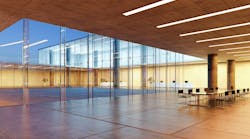Creating a good industrial lighting system involves considering numerous design criteria, while taking into account the visual tasks involved (the work) and the operating conditions at a facility. For that reason, the ANSI/IESNA Recommended Practice for Lighting Industrial Facilities RP-7-01, produced by the Illuminating Engineering Society of North America, serves as a useful educational tool. The 72-page book discusses the appropriate quantities of light for various tasks as well as the quality issues that are equally important to providing a comfortable and safe work atmosphere.
The book bases its recommended practices upon the following steps, but it takes into account that the importance of each may vary from one industry to the next:
- Determine the quality of illumination needed for a particular manufacturing process.
- Determine the quantity of illumination required at the task or process.
- Determine the appropriate lighting level required for safety, and ensure all three of the factors – quality, quantity and safety – are properly considered in the final design.
- Select the listed or approved lighting equipment that satisfies all the requirements, including mechanical performance.
- Prepare a lighting fixture layout that responds to the concerns of maintainability and safety.
- Review the energy, economic, and operating characteristics of the lighting system.
New for the 2001 edition, a three-page Lighting Design Guide allows a designer to weigh the importance of various factors. The columns of the guide list specific criteria related to a good visual environment, such as reflected glare and shadows, while the rows list specify tasks, such as machining or assembling. At each row/column intersection a shaded block indicates the level of importance for each criterion as it relates to the location or task: very important = solid shading; important = medium shading; somewhat important = light shading; and not important or not applicable = no shading (blank).
The quality factors to consider include:
Luminance and luminance ratios. The ability to see detail depends greatly on the contrast, or difference in luminance, between the task detail and its background. The greater the contrast, the easier it is to see the task. However, the human eye responds better when the luminances (brightness) within the field of vision is fairly uniform. Thus, all luminances in the field of view should be carefully controlled.
A Table in the guide offers various recommended maximum luminance ratios for six industrial areas, including the ratio between task and adjacent darker/lighter surroundings. Three columns titled A, B and C refer to the degree of reflectance control in the work area. The letters also relate to the practicality of changing these conditions at the facility in question.
Glare and visual comfort. Glare is anything that causes annoying discomfort or loss of visual performance and visibility. It can come directly from the lighting fixture or lamp, or indirectly from reflections off other surfaces in the area. Specifically, a person experiences disturbing or disabling glare when the luminance within the field of view exceeds the level to which the eyes have adapted.
The following steps can help minimize glare-producing conditions:
- Use a greater number of lower wattage lamps to reduce individual lamp brightness.
- Shield the lighting fixtures or place them at a higher elevation, above the workers’ usual field of view.
- Direct some light to the ceiling to balance space brightness ratios and reduce contrast between the ceiling and the fixtures.
- Install computer screens, or other reflective viewing surfaces, facing away from windows, skylights, or high lumen output fixtures.
Annoying flicker. One problem with any light source that operates on alternating current is lamp flicker. The problem occurs because the current of the lighting branch circuit passes through zero twice each cycle. For an incandescent source, this isn’t a serious concern because the filament doesn’t have time to cool down enough to noticeably affect light output. However, for both fluorescent and HID sources, the arc current is extinguished at each zero crossing and recreated constantly. This causes a 120 cycle-per-second flicker, which is most noticeable in peripheral vision and considered annoying. However, if someone observes rotating machinery under arc discharge lighting and the frequency of the lamp flicker approaches the speed of rotation, then the object appears to be rotating at a very slow speed. If the frequency and speed are matched, the object, such as a shaft or an impeller blade, will appear to be stationary. This can pose a danger to workers who may not recognize the machinery is rotating.
The problem can be minimized in several ways. When practical, lamps are mounted in pairs—one with a lagging lamp current and the other with a leading lamp current. The two waveforms are out of phase with each other. It’s also possible to connect adjacent fixtures to different phases of a 3-phase power system. Finally, visible flicker can be virtually eliminated when high frequency electronic ballasts, rather than core and coil magnetic ballasts, are used.
Color. Accurate color rendering is an important condition in industrial lighting systems. It can make it possible to conduct inspections for defects in products more rapidly. Additionally, the ability to see colors correctly is useful for the proper identification of safety colors used to highlight possible hazardous situations.
According to the guide, the quantity of light needed for the activity is considered after a quality analysis. The illuminance values (footcandles) for both the horizontal plane and vertical plane should be calculated. The vertical footcandle level is considered important today, since a great deal of assembly, fabrication, and processing involves 3-dimensional materials.
In most cases, the general lighting system isn’t adequate for detailed or close work.
Supplemental task lighting close to the work surface may also be needed because localized lighting optimizes energy use and gives workers the ability to adjust/control this lighting to meet their needs.
General lighting equipment. Just as important as the light itself are the pieces of the system that will create that light.
Luminaire types. Industrial high-intensity-discharge (HID) luminaires are generally divided into two categories. In a high-bay area, the spacing-to-mounting-height ratio is 1.0 or less, and the mounting height is not less than 25 feet. In a low-bay area, the spacing-to-mounting-height ratio is more than 1.0 and the mounting height is less than 25 feet.
The light distribution of high-bay HID fixtures is usually symmetrical, and is often adjusted to produce narrow to medium wide (44° to 60°) distribution with spacing criteria values of 1.0 or less.
In addition to HID fixtures, twin-tube, quad-tube, and linear fluorescent fixtures are also widely specified for manufacturing facilities and warehouses applications, and they can be placed under the same high-bay and low-bay categories.
In the past, lighting designers usually had to choose between metal-halide (MH) and high-pressure sodium (HPS) lamp, and HPS was frequently selected. Recently, the advent of pulse-start (high wattage, 175W to 1,000W), low-wattage (35/39W to 150W), and ceramic metal halide lamps has blurred the line between these choices.
Pulse-start MH lamp. Pulse-start ballast/metal halide (PS MH) lamp systems are proving to be a useful replacement for high-pressure sodium (HPS) systems in both high- and low-bay applications that require good color rendering characteristics. A pulse-start MH system can provide efficiencies that approach those of HPS systems – superior light output, high lumen maintenance, and long life – but without the yellowish look of the HPS lamp.
Other advantages of PS MH over conventional MH systems include the following:
- More lumens per watt. Lumen output increases by 25% to 50%, depending on lamp wattage and burning cycle.
- Improved lumen maintenance and longer lamp life by as much as 50%.
- Faster warm up and a faster re-strike time if the arc is interrupted while the lamp is hot.
- Reduced color shift, improved lamp-to-lamp color consistency, and a color rendering index (CRI) of up to 85, which offers a 30% improvement over the standard MH lamp.
A high-voltage igniter delivers a high-voltage pulse directly across the PS MH lamp’s operating electrodes, replacing the standard ballast’s 600V peak voltage and eliminating the standard MH lamp’s internal starting probe and its protective switch. Thus, the PS MH ballast’s open-circuit voltage requirement is reduced to the operating requirements of the lamp. This lower operating circuit voltage creates lower ballast operating temperatures, resulting in long ballast life, reduced maintenance/replacement costs, and the possibility of high fixture ambient temperature ratings.
In many cases, a 320W or 350W PS MH lamp can either replace a standard 400W MH lamp or make it possible to use fewer 400W PS MH fixtures in a lighting layout.
T8 fluorescent lamp. A number of technology improvements in linear fluorescent lamps greatly expand the selection for industrial applications. For example, second generation 800 series F32 T8 lamps (with matching electronic ballasts) are rated for 24,000 hours with 92% lumen maintenance. In addition, T8 fluorescent lamps keep up to 93% of full efficacy over a five-year average rated life.
Although fluorescents are available with up to 95 CRI, the lumens are much less than for 85 to 86 CRI fluorescent lamps. Most fluorescent highbay fixtures use 85-86 CRI lamps, which have much better color rendering than all HID, except the new ceramic pulse-start MH lamps that have 90 to 95 CRI, without sacrificing light output. For some applications, well-designed linear fluorescent highbays are better than well-designed HID highbays with regard to glare, contrast ratios, and vertical footcandles.
Direct/indirect fluorescent lighting provides a comfortable atmosphere for most industrial laboratories that handle tasks that range from critical research to routine preparation. This type of system minimizes reflected glare in a space where material, like glass metal containers, instrumentation and computer screens are found.
T5 fluorescent lamp. With a nominal 46-inch length, the T5 fluorescent source provides superior control and optical efficiency for both direct and pendant-mounted luminaires. A highly specular reflector used in conjunction with this long thin lamp can provide a candlepower distribution curve that offers a great deal of vertical footcandles, which are important in applications like warehouse rack aisles. A good high-bay fixture with four F54T5HO lamps (234W) can usually replace a standard 400W MH or a 320W PS MH high-bay fixture. The fixtures can have a horizontal, triangle, square, or cross configuration, and the reflector can provide direct, indirect, or direct/indirect distribution.
Compact fluorescent lamps. Improvements in compact fluorescent (CFL) lamp design, such as new amalgam technology, which provides a stable light output over a wide temperature range, result in longer life and higher wattage offerings. Ratings of 70W, 80W, and even 120W and lumen outputs of up to 9,000 lumens, allows these lamps to be used in high-ceiling or high-light-level applications, again competing with the MH lamp.
CFL fixtures that use multiple lamps are similar to HID fixtures in size and have the advantage of offering a tailored light output because of choices in lamp lumen output and the number of lamps used.
Fixture considerations. Classified areas, where flammable gas or vapors, combustible dust, or easily ignitable flyings or fibers are or can be present, should be of particular concern. The designer should check with the insurance carrier for the industrial site to determine the exact Class and Division for a specific area. Then the correct fixture can be selected. In an environment where greater protection for airborne particles is required, fluorescent fixtures are available with dust-tight covers. In damp locations, diffusers or lenses with vapor-tight gasketing are required.
In selecting equipment, study the luminaire catalogs for the values that indicate how comfortable or glare-free the lighting fixtures will be in a particular sized space. The United States uses the Visual Comfort Probability (VCP) rating, which applies only to lensed fixtures. A 70 and above VCP rating is considered good. In Europe, the Commission Internationale de l’Eclairage (CIE) uses a glare rating system called the Unified Glare Rating (UGR), which is more inclusive. Any UGR rating above 19 is unacceptable, and a difference in a single number on the scale is significant.
System economic analysis. A Simple Payback method offers an easy way to figure the cost of operating a lighting system. However this method doesn’t consider the cost or the lifetime value of the equipment. A second-level analysis considers more factors, including the cost of money over time and reducing the total lighting load (heat) will almost always lead to HVAC savings. A three-year payback, or a return on investment of 33.33% per year, is considered to be the benchmark for an investment in energy efficiency.





